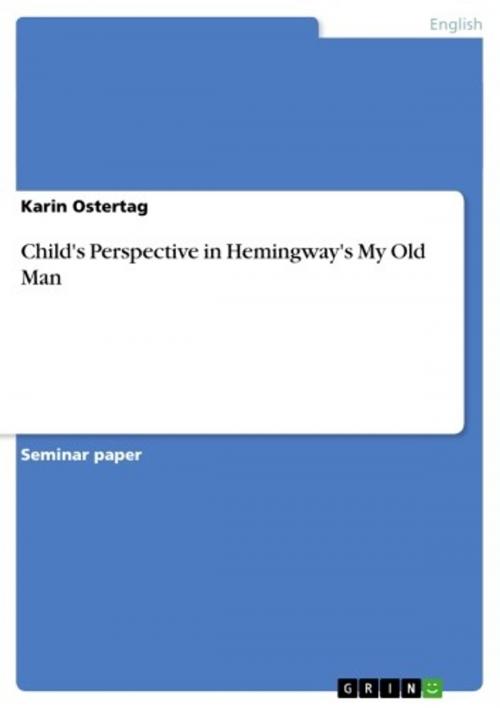| Author: | Karin Ostertag | ISBN: | 9783638174206 |
| Publisher: | GRIN Publishing | Publication: | February 27, 2003 |
| Imprint: | GRIN Publishing | Language: | English |
| Author: | Karin Ostertag |
| ISBN: | 9783638174206 |
| Publisher: | GRIN Publishing |
| Publication: | February 27, 2003 |
| Imprint: | GRIN Publishing |
| Language: | English |
Seminar paper from the year 2000 in the subject American Studies - Literature, grade: 1,3 (A), Humboldt-University of Berlin (Institute for Anglistics/American Studies), course: HS Childish 1st person perspective-artificial naivete?, 17 entries in the bibliography, language: English, abstract: [...] The first aspect is stressed especially by Jackson J. Benson when he compares 'My Old Man' and Anderson's 'I Want To Know Why' similar in view, subject, plot, tone, and diction. 'Both stories are about boys in a race track setting. Both boys admire an older man, are influenced by him, and then find their admiration betrayed. Both boys are left puzzled and hurt by the experience. Each story is told in the first person by the boy who is characterized by slightly broken grammar and the use of adolescent slang 'gee', 'gosh', and 'swell'.' (Benson, 273) Christian Messinger argues that 'Anderson sensed both the longing for success that gripped track people and the disorder that accompanied overidentification with horses and racing.' (Christian K. Messinger, 278) The following, however, will leave aside a possible influence by Anderson1 but rather concentrates on the employed narrating device of a child's raconteur. Although it suggests itself to compare the two narration modes, I am afraid I have to narrow my focus for the following examination. As Carl Ficken points out 'At the beginning of his writing career in the 1920's, Hemingway was working at (...) the problem of point of view. In his first publication, Three Stories and Ten Poems, 1923, he told two of the stories through an omniscient third-person narrator and the other in the first person (...) 'My Old Man' in fact, remains one of the classical examples of the unreliable first person narrator.' (Carl Ficken, 94) The following essay will thus discuss the second field of critical interest concerning 'My Old Man': the narrative revelation or more specific Hemingway's technique of establishing a child's perspective. Based on Franz K. Stanzel's three categories person, perspective and modus I will outline the typical features of the autobiographical I-narrator as Stanzel states them as relevant for interpretation. As I have pointed out the criteria that compose the I narrating situation I will on these grounds discuss further how a child's perspective as of the I-narrator, Joe, is established in 'My Old Man' and what function it serves in the story. 1 Hemingway vehemently denied the claimed influence of his elder patron that overshadowed his artist ego. With the bitter satire Torrents of Spring (1927) he publicly recoiled from Anderson and broke with him as a friend.
Seminar paper from the year 2000 in the subject American Studies - Literature, grade: 1,3 (A), Humboldt-University of Berlin (Institute for Anglistics/American Studies), course: HS Childish 1st person perspective-artificial naivete?, 17 entries in the bibliography, language: English, abstract: [...] The first aspect is stressed especially by Jackson J. Benson when he compares 'My Old Man' and Anderson's 'I Want To Know Why' similar in view, subject, plot, tone, and diction. 'Both stories are about boys in a race track setting. Both boys admire an older man, are influenced by him, and then find their admiration betrayed. Both boys are left puzzled and hurt by the experience. Each story is told in the first person by the boy who is characterized by slightly broken grammar and the use of adolescent slang 'gee', 'gosh', and 'swell'.' (Benson, 273) Christian Messinger argues that 'Anderson sensed both the longing for success that gripped track people and the disorder that accompanied overidentification with horses and racing.' (Christian K. Messinger, 278) The following, however, will leave aside a possible influence by Anderson1 but rather concentrates on the employed narrating device of a child's raconteur. Although it suggests itself to compare the two narration modes, I am afraid I have to narrow my focus for the following examination. As Carl Ficken points out 'At the beginning of his writing career in the 1920's, Hemingway was working at (...) the problem of point of view. In his first publication, Three Stories and Ten Poems, 1923, he told two of the stories through an omniscient third-person narrator and the other in the first person (...) 'My Old Man' in fact, remains one of the classical examples of the unreliable first person narrator.' (Carl Ficken, 94) The following essay will thus discuss the second field of critical interest concerning 'My Old Man': the narrative revelation or more specific Hemingway's technique of establishing a child's perspective. Based on Franz K. Stanzel's three categories person, perspective and modus I will outline the typical features of the autobiographical I-narrator as Stanzel states them as relevant for interpretation. As I have pointed out the criteria that compose the I narrating situation I will on these grounds discuss further how a child's perspective as of the I-narrator, Joe, is established in 'My Old Man' and what function it serves in the story. 1 Hemingway vehemently denied the claimed influence of his elder patron that overshadowed his artist ego. With the bitter satire Torrents of Spring (1927) he publicly recoiled from Anderson and broke with him as a friend.















